Garmin Bundle
How Did Garmin Navigate Its Way to Global Dominance?
Garmin's Garmin SWOT Analysis unveils a fascinating journey, beginning in 1989, that transformed how we explore the world. From pioneering GPS technology to becoming a household name, Garmin's story is one of relentless innovation and strategic expansion. Explore the remarkable Garmin history and discover the key milestones that shaped this tech giant.
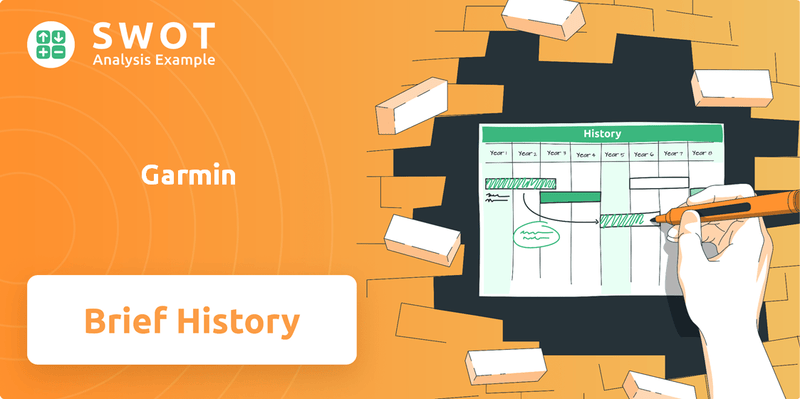
The Garmin company's origins lie in a vision to simplify and democratize GPS technology, a mission that continues to drive its success. This brief history of Garmin GPS devices reveals how early specialization in aviation and marine markets provided a solid foundation for diversification. Understanding when Garmin was founded and the early Garmin GPS technology is key to appreciating its current market position.
What is the Garmin Founding Story?
The Garmin company was founded on October 24, 1989. The company's name is a combination of the first names of its founders, Gary Burrell and Min Kao.
Both Burrell and Kao, electrical engineers, brought expertise in navigation technology. Burrell's background was in avionics, and Kao specialized in GPS technology and digital mapping. Their goal was to create and market GPS technology for different mobile markets.
The founders observed a gap in the market for affordable and user-friendly GPS devices. Existing GPS receivers were expensive and complex. Burrell and Kao sought to make this technology smaller and simpler for wider use. They initially targeted the marine and aviation industries. Their first product was the GPS 100AVD, designed for aviation and marine applications. The company started with personal savings and a small venture capital investment.
Garmin was founded in 1989 by Gary Burrell and Min Kao. They aimed to make GPS technology accessible to a broader market. The company's initial focus was on aviation and marine products.
- The founders chose 'Garmin' as the company name, a portmanteau of their names.
- Their first product, the GPS 100AVD, targeted aviation and marine users.
- The company was funded through personal savings and venture capital.
- The late 1980s saw increasing advancements in satellite technology, which influenced the company's creation.
Garmin SWOT Analysis
- Complete SWOT Breakdown
- Fully Customizable
- Editable in Excel & Word
- Professional Formatting
- Investor-Ready Format
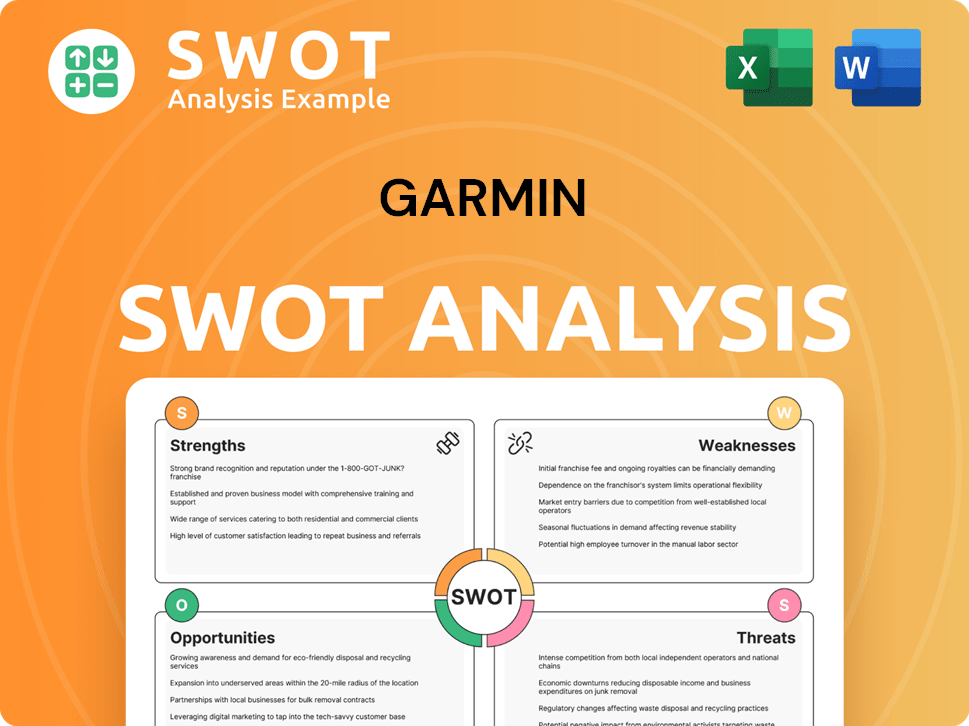
What Drove the Early Growth of Garmin?
The early growth of the Garmin company was marked by strategic product development and expansion into new markets. Following initial success in aviation and marine products, the company diversified its offerings. This expansion included venturing into outdoor recreation with portable GPS devices, which soon became a significant segment. Securing contracts with marine and aviation manufacturers was also a key milestone.
In the early 1990s, Garmin introduced portable GPS devices for outdoor enthusiasts, including handheld units for hiking and camping. This marked their entry into the outdoor recreation market, which quickly became a significant segment. The company's focus on user-friendly interfaces, robust hardware, and comprehensive mapping data allowed it to gain a significant market share. By 2024, the company's product range had expanded to include smartwatches, fitness trackers, and cycling computers, showcasing its commitment to innovation and market adaptation.
Early growth included securing contracts with various marine and aviation manufacturers, integrating Garmin GPS units directly into their vessels and aircraft. This strategy provided a strong foundation for market penetration. The company's vertically integrated business model allowed it to control the entire product development process, from design to manufacturing. This strategic decision enabled faster innovation cycles and higher quality control. In 2024, partnerships with major automotive manufacturers continued to be a key revenue driver.
Team expansion was gradual but steady, with a focus on bringing in engineers and sales professionals who understood the intricacies of GPS technology and its diverse applications. Early office locations were primarily in Olathe, Kansas, which remains a key operational hub. The company's growth efforts were also bolstered by its vertically integrated business model, which allowed it to control the entire product development process, from design to manufacturing. By 2024, the company had expanded its global presence with offices and manufacturing facilities worldwide.
A pivotal moment came with the introduction of the first portable GPS device for the automotive market, the StreetPilot, in 1998. This product revolutionized in-car navigation and paved the way for Garmin's dominance in the automotive segment for many years. The market reception was overwhelmingly positive, as consumers embraced the convenience and accuracy of turn-by-turn navigation. The success of the StreetPilot significantly boosted the company's revenue and market share. For more details on how they achieved this, check out the Marketing Strategy of Garmin.
Garmin PESTLE Analysis
- Covers All 6 PESTLE Categories
- No Research Needed – Save Hours of Work
- Built by Experts, Trusted by Consultants
- Instant Download, Ready to Use
- 100% Editable, Fully Customizable
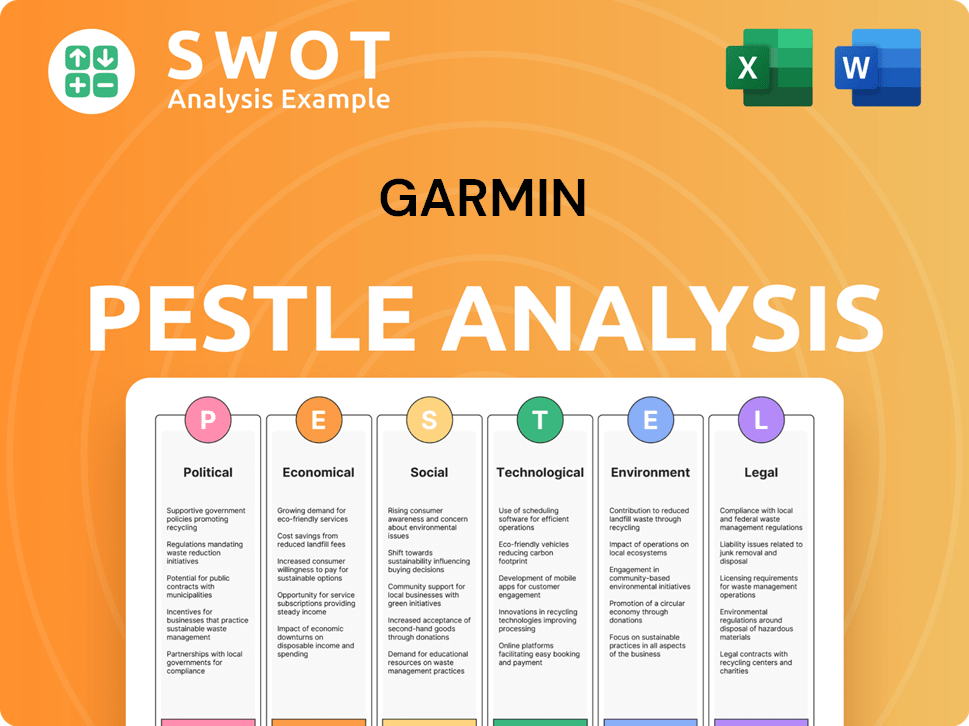
What are the key Milestones in Garmin history?
The Garmin company has a rich Garmin history marked by significant milestones and strategic shifts. From its origins to its current status as a leader in GPS technology, the Garmin timeline reveals a journey of innovation, adaptation, and expansion across various markets.
| Year | Milestone |
|---|---|
| 1989 | Garmin founder Gary Burrell and Min Kao established the company, initially focusing on GPS technology for aviation. |
| Early 2000s | Revolutionized the automotive market with the nüvi series of personal navigation devices (PNDs), becoming a household name. |
| Mid-2000s | Introduced the Forerunner series of GPS-enabled running watches, pioneering the integration of GPS tracking into wearable technology. |
| 2023 | Generated over $1.6 billion in revenue from the wearables market, showcasing a strong presence in the fitness segment. |
Garmin has consistently pushed the boundaries of GPS technology, creating products that have transformed how people navigate and track their activities. Their innovations have not only improved user experiences but also expanded the company's reach into new markets.
The nüvi series of PNDs brought user-friendly navigation to the masses, featuring intuitive touchscreens and preloaded maps. This innovation made Garmin GPS a standard in vehicles worldwide.
The Forerunner series of GPS-enabled running watches marked a significant entry into the fitness market, integrating GPS tracking into wearable devices. This led to a strong presence in the booming wearables market.
Garmin has been a key player in aviation, providing advanced avionics and navigation systems for general aviation and commercial aircraft. This has been a core area of innovation and growth for the company.
Garmin has expanded its marine electronics offerings, providing chartplotters, fishfinders, and other navigation tools for recreational and commercial boating. This has helped diversify the company's revenue streams.
Garmin has developed rugged GPS devices and smartwatches for outdoor enthusiasts, offering features like satellite communication and long battery life. This has helped the company cater to a niche market.
Garmin has introduced solar-charging technology in some of its smartwatches, significantly extending battery life for outdoor use. This innovation enhances the usability of its products.
Despite its successes, Garmin has faced challenges, including intense competition and market shifts. The company has responded by adapting its strategies and diversifying its product offerings to maintain its market position.
The rise of free smartphone navigation apps posed a significant threat to Garmin's automotive PND business. This forced the company to pivot and diversify its product portfolio.
Intense competition in the wearables market from tech giants has required Garmin to focus on niche markets and professional-grade features. This has helped it maintain a competitive edge.
Garmin has learned the importance of adaptability, continuous innovation, and diversification to transform challenges into opportunities for growth. This has reinforced its position as a leader in specialized GPS solutions.
Garmin has made significant R&D investments in new product categories such as smartwatches and cycling computers. These investments have been crucial for maintaining its competitive advantage.
Garmin has secured patents for various GPS and sensor technologies, reinforcing its innovative edge. This helps protect its intellectual property and maintain its market position.
The company strategically shifted its focus from solely PNDs to a more diversified product portfolio, including aviation, marine, outdoor, and fitness segments. This strategy allowed them to leverage their core GPS expertise.
For more insights into Garmin's financial performance and ownership structure, consider reading the article about Owners & Shareholders of Garmin.
Garmin Business Model Canvas
- Complete 9-Block Business Model Canvas
- Effortlessly Communicate Your Business Strategy
- Investor-Ready BMC Format
- 100% Editable and Customizable
- Clear and Structured Layout
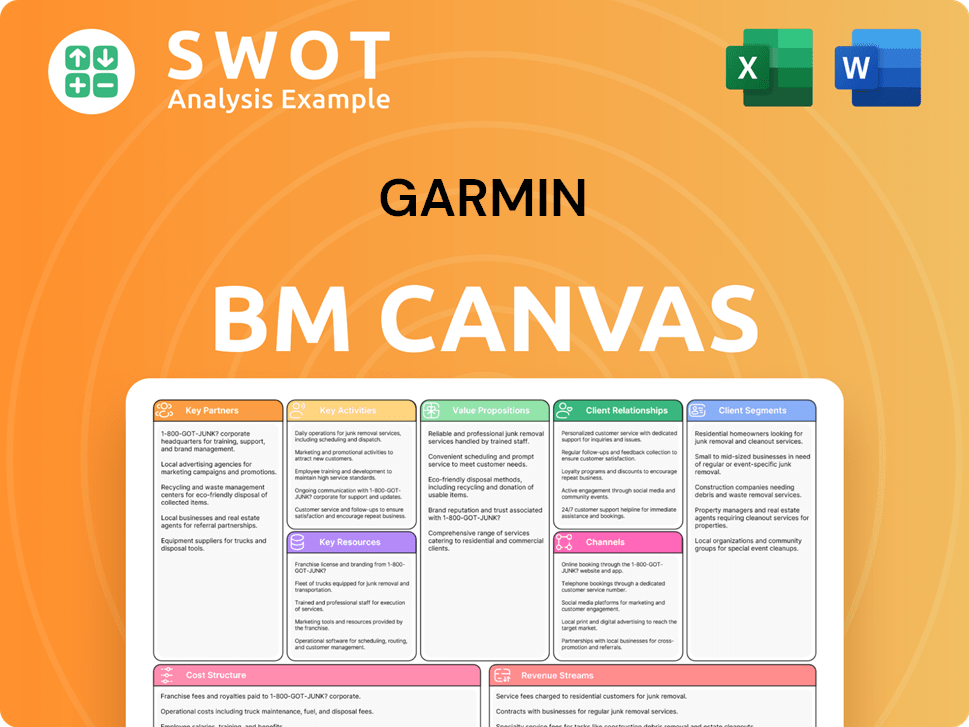
What is the Timeline of Key Events for Garmin?
The Garmin company journey, a story of innovation and expansion, began with its foundation and has since evolved into a leader in GPS technology. The company's history is marked by strategic product launches and market entries, transforming from a GPS device manufacturer to a diversified technology corporation. This evolution reflects a commitment to adapting to technological advancements and consumer demands, solidifying its position in various sectors.
| Year | Key Event |
|---|---|
| 1989 | Founded by Gary Burrell and Min Kao, marking the beginning of the Garmin company. |
| 1991 | Introduced the GPS 100AVD, its first product for aviation and marine applications, expanding into specialized markets. |
| 1998 | Launched the StreetPilot, its initial automotive GPS device, entering the consumer market. |
| 2000 | Went public on NASDAQ, providing capital for expansion and innovation. |
| 2003 | Introduced the Forerunner, its first GPS-enabled fitness watch, entering the wearables market. |
| 2006 | The nüvi series became a dominant force in the personal navigation device market, increasing market share. |
| 2010 | Diversification accelerated as smartphone navigation apps gained traction, adapting to changing consumer preferences. |
| 2014 | Acquired Fusion Entertainment, expanding marine audio capabilities and enhancing product offerings. |
| 2019 | Introduced the MARQ series, a collection of modern tool watches, expanding into premium product lines. |
| 2023 | Reported revenue of $5.23 billion, demonstrating strong performance across segments. |
| 2024 | Continued focus on expanding the appeal of its wearables and outdoor products, including new features like advanced health metrics and solar charging. |
Garmin plans to broaden its reach in aviation, marine, and outdoor recreation. This strategy capitalizes on its established brand and technical expertise. The company aims to enhance its connected ecosystem and integrate advanced health and wellness features into its wearables. This will cater to evolving consumer needs and market trends.
The company intends to explore new applications for its GPS technology. This includes areas like autonomous systems and precision agriculture. Garmin is expected to focus on premium products with higher profit margins. This will appeal to customers who value reliability and advanced features.
The demand for personalized health monitoring is increasing, along with outdoor recreational activities. The aviation and marine industries are also undergoing digitalization. Analyst predictions anticipate continued growth in the fitness and outdoor segments. These trends support Garmin's strategic direction.
Garmin's CEO, Cliff Pemble, emphasizes the company's commitment to innovation and customer satisfaction. This is crucial for its continued success. The company aims to deliver leading products that enhance customer experiences. This approach aligns with the original vision of making sophisticated navigation accessible.
Garmin Porter's Five Forces Analysis
- Covers All 5 Competitive Forces in Detail
- Structured for Consultants, Students, and Founders
- 100% Editable in Microsoft Word & Excel
- Instant Digital Download – Use Immediately
- Compatible with Mac & PC – Fully Unlocked
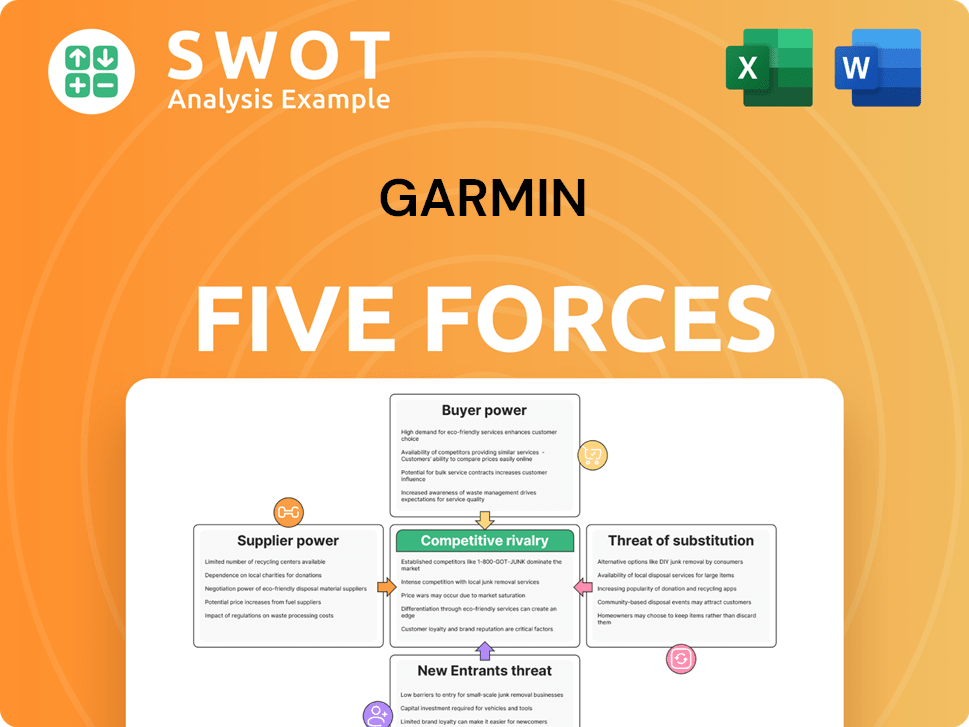
Related Blogs
- What is Competitive Landscape of Garmin Company?
- What is Growth Strategy and Future Prospects of Garmin Company?
- How Does Garmin Company Work?
- What is Sales and Marketing Strategy of Garmin Company?
- What is Brief History of Garmin Company?
- Who Owns Garmin Company?
- What is Customer Demographics and Target Market of Garmin Company?
Disclaimer
All information, articles, and product details provided on this website are for general informational and educational purposes only. We do not claim any ownership over, nor do we intend to infringe upon, any trademarks, copyrights, logos, brand names, or other intellectual property mentioned or depicted on this site. Such intellectual property remains the property of its respective owners, and any references here are made solely for identification or informational purposes, without implying any affiliation, endorsement, or partnership.
We make no representations or warranties, express or implied, regarding the accuracy, completeness, or suitability of any content or products presented. Nothing on this website should be construed as legal, tax, investment, financial, medical, or other professional advice. In addition, no part of this site—including articles or product references—constitutes a solicitation, recommendation, endorsement, advertisement, or offer to buy or sell any securities, franchises, or other financial instruments, particularly in jurisdictions where such activity would be unlawful.
All content is of a general nature and may not address the specific circumstances of any individual or entity. It is not a substitute for professional advice or services. Any actions you take based on the information provided here are strictly at your own risk. You accept full responsibility for any decisions or outcomes arising from your use of this website and agree to release us from any liability in connection with your use of, or reliance upon, the content or products found herein.